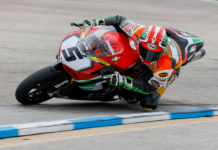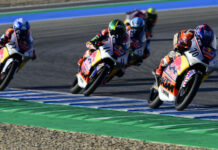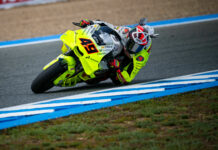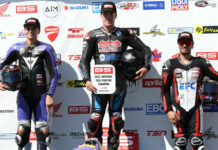From a press release issued by the FIM:
Mies, November 8/le 8 novembre 2002
Superbike & Supersport World Championships
Regulations – Decisions of the Superbike Commission
The Superbike Commission, composed of Messrs. Claude Danis (FIM), Paolo Alberto Flammini (SBK International), Takanao Tsubouchi (MSMA) and Giulio Bardi (Team representative), has unanimously decided to introduce the following modifications to the Road Racing World championship Regulations for Superbike and Supersport (application as from 1.1.2003):
Tyres (Superbike – to be added to Art. 2.4.6.7):
At each event, during free practices, qualifying practices and Superpole, a maximum of 13 rear slick tyres may be used. A Technical Steward must mark these 13 tyres. There is no restriction on the number of front or wet tyres that may be used. On race day, there is no restriction on the number of rear slick tyres that may be used. During free practices, qualifying practices and Superpole, no motorcycle may enter the track without the rear slick tyre being marked. If a rider is given a red flag during a Superpole lap for reasons beyond the rider’s control, the Technical Director may allow an additional rear slick tyre to be used.
Fuel pump (Superbike – replaces the 3rd paragraph of Art. 2.4.9):
Electric fuel pumps must be wired through a circuit cut-out, which will operate automatically when the motorcycle is on its side. This circuit cut-out must de-activate the fuel pump and the ignition system within one second. The de-activation of the fuel pump and the ignition system may be checked anytime during the event at the instruction of the Technical Director.
Tyres (Supersport – Art. 2.5.6.7, replaces previous text):
Tyres must be a fully molded type carrying all size and sidewall marking of the tyres for commercial sale to the public. Tyres of V and Z rating must be used. The depth of the tyre treads must be at least 2.5 mm over the entire tyre pattern width at a pre-race control. The tyres must have a positive and negative tread of 96% positive and minimum 4% negative (land and sea ratio). The maximum distance from the external edge of the tyre to 50% of the tread elements is 35 mm.
One size for the front and two sizes for the rear are allowed. Each size, front and rear, must be available with the same tread pattern as the commercial tyres for the road use. The manufacturers may only submit one front and rear pattern for approval. The previous approved tyre pattern will expire one year after the introduction of a new approved tyre pattern.
The FIM/CCR will grant the approval. The manufacturers must submit the tyre for approval 30 days prior to its first use. Templates proving the land and sea ratio must be included. The tyres must have a DOT and/or E mark. The DOT and/or E mark must appear on the tyre sidewall.
Only when a race or practice has been declared “wet”, the use of a special tyre commonly known as a full wet tyre is allowed. Wet tyres must be a fully molded tyre, no hand cutting is allowed on molded tyres. The use of hand cut tyres is not allowed. Wet tyres do not need to carry DOT or E marks; however these tyres must be marked “Not for Highway Use” or “NHS”.
At each event, during free practices and qualifying practices, a maximum of 12 rear tyres may be used. A Technical Steward must mark these 12 tyres. There is no restriction on the number of front or wet tyres that may be used. On race day, there is no restriction on the number of rear tyres that may be used. During free and qualifying practice, no motorcycle may enter the track without the rear tyre being marked.
Cylinder Head (Supersport – replaces the last sentence of paragraph 6, Art. 2.5.6.20):
The use of titanium valves are permitted for use in machines that are equipped with titanium valves in the original homologated machine.
Fuel pump (Supersport – replaces the 3rd paragraph of Art. 2.5.9):
Electric fuel pumps must be wired through a circuit cut-out, which will operate automatically when the motorcycle is on its side. This circuit cut-out must de-activate the fuel pump and the ignition system within one second. The de-activation of the fuel pump and the ignition system may be checked anytime during the event at the instruction of the Technical Director.
Superbike Homologation Information
Homologation extension for 1000cc 4-cylinder motorcycles for 2003
– A manufacturer having a valid Stocksport or Superproduction homologation for a 1000cc 4-cylinder motorcycle will automatically receive a Superbike homologation for this motorcycle. This will be done by adding the motorcycle to the Superbike homologation list and informing the manufacturer.
– If the manufacturer wishes to add an optional carburation instrument, a homologation of the optional carburation instrument will be required. The FIM will charge the homologation fee.
– If no Stocksport or Superproduction homologation exists, then a new Superbike homologation will be required.
Superbike Commission Modifies World Superbike And World Supersport Rules
Superbike Commission Modifies World Superbike And World Supersport Rules
© 2002, Roadracing World Publishing, Inc.






